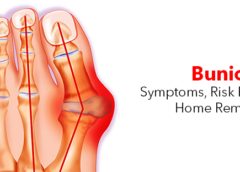Overview
A bunion is a bony bump at the base of your big toe which forms on the joint. It occurs when any of the bones those are in the front of your foot move out of place. It causes the big toe tip to be pushed toward the smaller toes, which allows the joint to stick out at the base of the big toe. Might be red and sore on the skin above the bunion.
Narrow, tight shoes could cause bunions or make them worse. Bunions can also develop due to your foot shape, foot deformity or medical condition, such as arthritis.
Smaller bunions (bunionettes) on your little toe joint may grow.
Symptoms
A bunion’s classic symptom is a bump which forms at the base of the large toe. These can also develop at the small toe’s base. When this occurs, a doctor will treat bunionette or “bunion tailor’s”
Other symptoms of bunions may include:
- Pain and soreness
- Numbness
- A burning sensation
- Swelling at the affected toe joint
- The thickness of the skin at the base of the affected toe increased
- Hardened skin under the foot
- Redness
- Bump on the base of the toe affected
- The presence of corns or calluses
- Movement restriction within the affected toe
The symptoms can worsen by wearing narrow shoes and high heels, or by standing for a long time.
Bunions start as tiny lumps. However, they get worse over time and cause discomfort and find it difficult to walk.
When to see a doctor
Although bunions often need no medical attention, if you have: see your doctor or a doctor who is specialized in the attention of foot disorders (podiatrist or orthopaedic foot specialist):
- Ongoing big toe or foot pain
- A noticeable bump on the big toe joint
- Reduce movement of the big toe or foot
- Trouble finding correctly fitted shoes because of bunion
Causes
Many medical scientists believe people inherit the bone structure which causes the development of bunions.
Other factors, like, contribute to the risk of developing a bunion.
- Over-Pronation, which means having a low arch or uneven weight-bearing in the foot and tendon that makes the toe joint unstable
- Hypermobility, or making a large toe bone moving faster than normal
- Foot Injuries
- Types of Arthritis, such as rheumatoid arthritis
- Conditions that affect both the nerves and muscles, such as polio
This can also increase the risk of the feet do not grow properly before birth.
Some people say high-heeled or narrow shoes are promoting bunion development. They may aggravate existing bunions or cause bunions to develop in people with a genetic risk of the condition but they do not directly cause bunion development.
A systematic study of 2014 shows that about 2 per cent of children under the age of 10 have this disorder and almost half of all adults.
Adolescent bunions are the most likely to occur in girls aged 10 to 15. Generally, this tendency occurs within families.
A younger person with bunion normally will push his or her toe up and down. In adults, a bunion has a greater risk of limiting mobility.
Risk Factors
These factors might increase your risk of bunions:
High Heels: Wearing high heels pushes your feet into your shoes in front of you, sometimes crowding your toes.
Fitting Shoes: People who wear too tight, too narrow or too pointy shoes are more likely to develop bunions.
Rheumatoid Arthritis: Having this inflammatory disorder will increase the risk of developing bunions.
Heredity: The tendency to develop bunions could be due to an inherited problem with your foot’s structure or anatomy.
Complications
Bunions can lead to other conditions, including:
- Bursitis, This painful condition occurs when there is inflammation of the small fluid-filled pads that cushion the bones near your joints. Or swelling the pads filled with fluids that are responsible for cushioning the bones, tendons and muscles.
- Hammertoe, An irregular bend in the middle of the toe joint, normally the toe next to your big toe, can cause pain and pressure. Where irregular joint bending leads to tension and pain.
- Metatarsalgia, or swelling and football pain calluses
- Pain
- Difficulty Walking
- Decreased mobility in the toes
- Arthritis
Home remedies
Avoiding shoes cramping the feet is one way to avoid any of those problems from forming.
Lifestyle adaptations to relieve bunions include:
- Appropriately Fitting Footwear: Shoes which leave enough room for the toes inside may relieve pressure.
- Foot Measuring: A good shoe shop will measure your feet and advise you on appropriate footwear options.
- Shoe Inserts: Also known as orthotics, inserts relieve pressure on the toe. Orthotics are available for purchase online.
- Padding, Taping, or Splinting of the toe: It will help in providing encouragement and reducing discomfort.
- Avoiding activities that increase pain: Such behaviours may include standing for a long time or playing contact sports.
- Ice: ice can help to minimize swelling by adding ice to the affected area.

Leave a Reply
You must be logged in to post a comment.